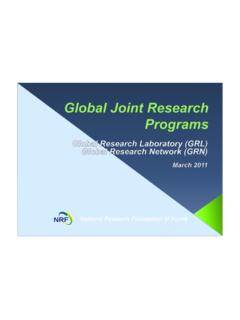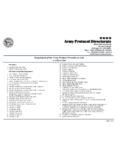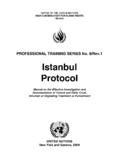Transcription of Guide to Cost-Benefit Analysis of Investment Projects
1 Guide to Cost-Benefit Analysis of Investment Projects Economic appraisal tool for Cohesion Policy 2014-2020. December 2014. Regional and Urban Policy Europe Direct is a service to help you find answers to your questions about the european Union. Freephone number (*): 00 800 6 7 8 9 10 11. (*) The information given is free, as are most calls (though some operators, phone boxes or hotels may charge you). european commission . directorate - general for Regional and Urban policy REGIO DG 02 - Communication Mrs Ana-Paula Laissy Avenue de Beaulieu 1. 1160 Brussels BELGIUM. E-mail: Internet: More information on the european Union is available on the Internet ( ). Luxembourg: Publications Office of the european Union, 2015. ISBN 978-92-79-34796-2. european Union, 2015. Reproduction is authorised provided the source is acknowledged. Printed in Italy Printed on elemental chlorine-free bleached paper (ECF). Guide to Cost-Benefit Analysis of Investment Projects Economic appraisal tool for Cohesion Policy 2014-2020.
2 european commission directorate - general for Regional and Urban policy 2 G U I D E TO C O S T - B E N E F I T A N A LY S I S O F I N V E S T M E N T P R OJ E C T S. ACKNOWLEDGEMENTS AND DISCLAIMER. Authors: Davide Sartori (Centre for Industrial Studies [CSIL]), Lead author; Gelsomina Catalano, Mario Genco, Chiara Pancotti, Emanuela Sirtori, Silvia Vignetti (CSIL); Chiara Del Bo (Universit degli Studi di Milano). Academic Panel Review: Massimo Florio (Universit degli Studi di Milano), Panel Coordinator; Per-Olov Johansson (Stockholm School of Economics), Susana Mourato (London School of Economics & Political Science), Arnold Picot (Ludwig- Maximilians-Universit t, Munich), Mateu Turr (Universitat Polit cnica de Catalunya). Technical advisory: JASPERS acted as technical advisor to DG REGIO for the preparation of this Guide , with a focus on the practical issues related to the CBA of major infrastructure Projects . In particular, besides peer reviewing the early drafts of the Guide , JASPERS contributed by highlighting best practice and common mistakes in carrying out CBA as well as with the design and development of the seven case studies included in the Guide .
3 The JASPERS team was composed of experts in all sectors covered by the Guide . It was led by Christian Schempp and Francesco Angelini and included Patrizia Fagiani, Joanna Knast-Braczkowska, Marko Kristl, Massimo Marra, Tudor Radu, Paul Riley, Robert Swerdlow, Dorothee Teichmann, Ken Valentine and Elisabet Vila Jorda. The authors gratefully acknowledges very helpful comments by Witold Willak, Head of Sector, Major Project Team, the european commission directorate - general for Regional and Urban Policy, who has been in charge of the management of the service, by Mateusz Kujawa, european commission directorate - general for Regional and Urban Policy, by the members of the Academic Panel Review, by experts from JASPERS and the european Investment Bank (EIB), as well as participants in the Steering Committee meetings including desk officers from the european commission Directorates- general for Communications Networks, Content and Technology, for Climate Action, for the Environment, for Energy, for Mobility and Transport, for Regional and Urban Policy and for Research and Innovation.
4 In some cases, constraints of space, of time, or scope of the Guide have limited the possibility by the authors to fully include all the suggested changes to earlier drafts. The usual disclaimer applies and the authors are responsible for any remaining omissions or errors. The european commission and the authors accept no responsibility or liability whatsoever with regard to this text. This material is: information of general nature which is not intended to address the specific circumstances of any particular individual or entity;. not necessarily comprehensive, accurate or up to date. It is not meant to offer professional or legal advice. Reproduction or translation is permitted, provided that the source is duly acknowledged and no modifications to the text are made. Quotation is authorised as long as the source is acknowledged along with the fact that the results are provisional. G U I D E TO C O S T - B E N E F I T A N A LY S I S O F I N V E S T M E N T P R OJ E C T S 3.
5 LIST OF ABBREVIATIONS. BAU Business As Usual CBA Cost-Benefit Analysis CF Conversion Factor DCF Discounted Cash Flow EC european commission EIA Environmental Impact Assessment EIB european Investment Bank ENPV Economic Net Present Value ERDF european Regional Development Fund ERR Economic Rate of Return ESI european and Structural Investment EU european Union FDR Financial Discount Rate FNPV Financial Net Present Value FRR(C) Financial Rate of Return of the Investment FRR(K) Financial Rate of Return on National Capital GDP Gross Domestic Product GHG Green House Gas IWS Integrated Water Supply LRMC Long Run Marginal Cost MCA Multi-Criteria Analysis NACE Statistical classification of economic activities MS Member State OP Operational Programme O&M Operation & Maintenance PPP Public-Private Partnership QALY Quality-Adjusted Life Year SCF Standard Conversion Factor SDR Social Discount Rate STPR Social Time Preference Rate VAT Value Added Tax VOSL Value of Statistical Life VOT Value of Time WTP Willingness-to-pay WTA Willingness-to-accept WWTP Waste Water Treatment Plant G U I D E TO C O S T - B E N E F I T A N A LY S I S O F I N V E S T M E N T P R OJ E C T S 5.
6 Table of Contents Foreword 11. Introduction 13. 1. CBA in the framework of the EU funds 15. Introduction 15. Definition and scope of Major Projects ' 15. Information required, roles and responsibility for the appraisal 17. Consistency with recent policy developments 21. 2. general principles for carrying out cost benefit Analysis 25. Introduction 25. Project appraisal steps 27. Description of the context 29. Definition of objectives 30. Identification of the project 31. Physical elements and activities 31. The body responsible for project implementation 32. Who has standing 33. Technical feasibility and environmental sustainability 34. Demand Analysis 35. Option Analysis 36. Environment and climate change considerations 38. Technical design, cost estimates and implementation schedule 40. Financial Analysis 41. Introduction 41. Methodology 41. Investment cost, replacement costs and residual value 44. Operating costs and revenues 45.
7 Sources of financing 47. Financial profitability 48. Financial sustainability 50. Financial Analysis in Public Private Partnership (PPP) 52. Economic Analysis 54. Introduction 54. Fiscal corrections 55. From market to shadow prices 56. Application of Conversion Factors to project inputs 58. The shadow wage 58. Evaluation of direct benefits 59. Evaluation of non market impacts and correction for externalities 61. Evaluation of GHG emissions 62. The residual value 63. Indirect and distributional effects 64. Economic performance 65. Risk assessment 67. Sensitivity Analysis 67. Qualitative risk Analysis 69. 6 G U I D E TO C O S T - B E N E F I T A N A LY S I S O F I N V E S T M E N T P R OJ E C T S. Probabilistic risk Analysis 71. Risk prevention and mitigation 73. Checklist 75. 3. Transport 77. Introduction 77. Description of the context 79. Definition of objectives 79. Project identification 80. Forecasting traffic volume 81.
8 Factors influencing demand Analysis 81. Hypotheses, methods and input 82. Outputs of the traffic forecast 83. Option Analysis 84. Financial Analysis 84. Investment costs 84. Operation and Maintenance (O&M) costs 85. Revenue projections 85. Economic Analysis 87. Travel time 90. Road users Vehicle Operating Costs 94. Operating costs for service carriers 95. Accidents 95. Noise 97. Air pollution 98. Climate change 99. Risk assessment 99. Case study - Road Project 101. Case study - Railway 113. Case study Urban Transport 127. 4. Environment 145. Water supply and sanitation 145. Description of the context 147. Definition of objectives 148. Project identification 148. Demand Analysis 149. Factors influencing water demand 149. Hypotheses, methods and input data 149. Output of demand forecasting 150. Option Analysis 151. Financial Analysis 151. Investment cost 151. Operation and Maintenance (O&M) costs 152. Revenues projections 152.
9 Economic Analysis 153. Increased availability of drinking water supply and/or sewer services 153. Improved reliability of water sources and water supply service 154. Improved quality of drinking water 154. Improved quality of surface water bodies and preservation of ecosystem services 155. Water preserved for other uses 155. Health impacts 156. Reduced congestion 156. Variation in GHG emissions 157. Risk assessment 157. G U I D E TO C O S T - B E N E F I T A N A LY S I S O F I N V E S T M E N T P R OJ E C T S 7. Waste management 158. Description of the context 159. Definition of objectives 160. Project identification 160. Demand Analysis 161. Factors influencing waste demand 161. Hypotheses, methods and input data 161. Option Analysis 162. Financial Analysis 163. Investment cost 163. Operation and Maintenance costs 163. Revenues projections 164. Economic Analysis 165. Resource savings: avoided waste to landfill 165.
10 Resource savings: recovery of recyclable materials and production of compost 166. Resource savings: energy recovered 166. Visual disamenities, noise and odours 166. GHG emissions 167. Health and environmental hazards 168. Risk assessment 168. Environment remediation, protection and risk prevention 170. Introduction 170. Description of the context 171. Definition of objectives 171. Project identification 172. Demand Analysis 173. Financial Analysis 173. Investment and operating costs 173. Revenue projections 173. Economic Analysis 173. Improved health conditions 174. Productive use of land 175. Increased recreational value 175. Ecosystem and biodiversity preservation 175. Reduction of damages to properties 176. Increase in property values 176. Risk assessment 177. Case Study Water and Waste Water Infrastructure 179. Case Study Waste Incinerator with Energy Recovery 191. 5. Energy 211. Introduction 211. Description of the context 213.















